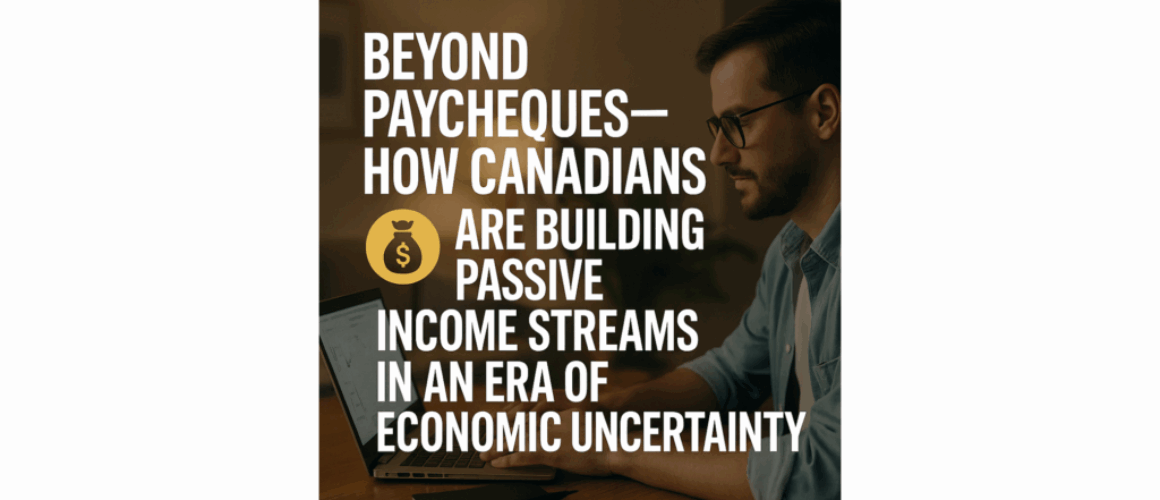Beyond Paycheques – How Canadians Are Building Passive Income Streams in an Era of Economic Uncertainty
In 2025, the phrase “side hustle” has evolved. No longer synonymous with driving for Uber or selling on Etsy, a growing number of Canadians are now turning to passive income strategies as a means of regaining control over their financial futures. From REITs and dividends to high-yield savings automation and digital product royalties, the modern middle-class investor is building “micro-portfolios” of income — even without substantial capital to begin with.
This shift is not driven by greed — but by necessity.
With inflation lingering above wage growth, interest rates staying elevated, and job security feeling fragile across many sectors, passive income has transformed from a financial bonus into a survival strategy.
The Quiet Revolution of Everyday Investors
According to a recent Scotiabank poll, 41% of Canadians aged 30 to 55 say they are actively working toward building passive income. The top motivations? Supplementing unpredictable wages, offsetting rising housing costs, and preparing for early retirement or a potential career pivot.
What’s notable is that these investors aren’t waiting for windfalls. They’re starting small, using automation, compound interest, and modern platforms that enable fractional investing.
Dividend investing is leading the charge. Through apps like Wealthsimple and Questrade, Canadians are building positions in high-yield blue-chip stocks — often reinvesting dividends into new shares and leveraging DRIP (Dividend Reinvestment Plans). It’s not glamorous, but it works.
Others are venturing into real estate crowdfunding platforms, such as Addy or Willow, which allow Canadians to invest in commercial or residential properties for as little as $250 — generating monthly rent-based dividends with little to no management responsibility.
Monetizing Knowledge and Creativity
Another major passive income channel is digital product creation. Teachers are earning royalties on education PDFs sold on marketplaces like Teachers Pay Teachers. Hobbyists are publishing niche ebooks or print-on-demand journals via Amazon KDP. Musicians and podcasters are uploading royalty-bearing content on platforms like Spotify and Patreon.
The pandemic, for all its disruption, democratized digital tools — and 2025 is proving that Canadians are still leveraging those tools to create monetizable content.
Freelancers and professionals are also pre-building evergreen online courses on platforms like Teachable and Thinkific — earning income every time someone enrolls. While not entirely passive in the setup stage, these projects offer long-tail revenue that can scale with little maintenance.
Caution: Scams, Taxes, and Unrealistic Expectations
The rise of passive income culture has also brought pitfalls. YouTube is full of “$10,000 a month” passive income claims, many of which oversell the simplicity and understate the time investment. Financial advisors are urging Canadians to separate marketing from reality and to understand risk before diving into affiliate programs, crypto staking, or drop-shipping.
Moreover, the tax implications of passive income are often misunderstood. Rental and dividend income are taxed differently than wages. Capital gains have their own set of rules. With the Canada Revenue Agency (CRA) increasing audits of gig and side income, transparency and good bookkeeping are essential.
“We’re seeing a rise in side income, but not always in side accounting,” warns Ayesha Taggar, a Toronto-based tax lawyer. “People assume if it’s digital, it’s invisible. It’s not.”
A Cultural Shift Toward Autonomy
What unites this movement is mindset. Canadians are no longer relying on a single employer, pension, or RRSP to carry them through retirement. Instead, they are assembling personal financial ecosystems — a mix of recurring cash flows, smart tax planning, and digital monetization.
This is not about quitting jobs, but reclaiming leverage in a system where living costs are outpacing traditional incomes. It’s about diversifying not just assets — but opportunity.
Conclusion: Passive Income, Active Strategy
Passive income may sound effortless, but it requires planning, research, and long-term thinking. It’s not a get-rich-quick route — it’s a path to stability in an unpredictable economy.
As more Canadians explore this avenue, the conversation around work, money, and freedom will continue to evolve — quietly, steadily, and with purpose.
